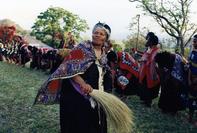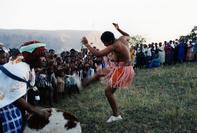Important Part of Zulu Life
Music, song and dancing have traditionally played an important part in Zulu life, not only of the individual, but also of the community as a whole.

Dance has always been important in maintaining a sense of group solidarity, particularly during times of stress, joy and change, for example, before battles, at weddings and at all the important transition ceremonies marking the entry to a new stage or group - usually an age-set.
Musical instruments were not used in most traditional Zulu dances, and neither was the drum, so common in other groups. Indeed, the only drum known in early traditional Zulu culture was the iNgungu, or pot-drum, which was made by stretching a piece of goat skin over the mouth of a large earthen pot 'imbiza' and played by tapping with the hand. From available records, it would appear that the isigubu, or wooden drum, that is common among the Zulu today was copied, possibly from their Thonga neighbours.
The Zulu had a number of stringed instruments of which the uGubu, a stringed bow with a calabash attached at one end, was the best known. Dancing has always had great ritual value in the lives of the Zulu, and there are many occasions in Zulu life when it forms a vital part of the ceremonial procedure for important events.
Ceremonies with Meaning

For example, when a boy or girl reaches puberty, specific songs are sung, accompanied by much dancing. The same applies to marriage, where the ritualized mutual antagonism between the two parties is portrayed by an elaborate dancing competition that forms an important part of every wedding ceremony.
Especially in the past, when hunting was still common, dancing also had ritual value before a hunt. Prior to setting out, the men gathered in the cattle byre where they danced, boasting of their prowess and what they would do and how brave they would be on the hunt. In this way, enthusiasm for the hunt was stimulated and expectations heightened.
The most spectacular and imposing of all Zulu dancing was that of the king's regiments in full regimental dress prior to battle and at the annual dances at the king's palace just after the Feast of the First Fruits.
The soldiers' dancing routines were energetic and powerful, precise in timing and posture and very well rehearsed. The effect of this, combined with their elaborate regimental attire, was awesome indeed.